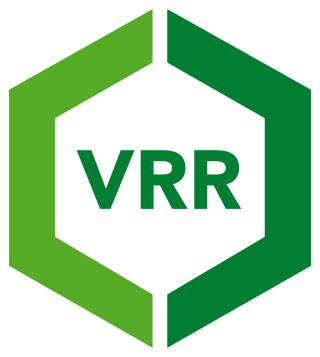
Bochum is a city in North Rhine-Westphalia. With a population of 372,348, it is the sixth largest city in one of the most populous German federal states of North Rhine-Westphalia, and the 16th largest city of Germany. On the Ruhr Heights (Ruhrhöhen) hill chain, between the rivers Ruhr to the south and Emscher to the north, it is the second largest city of Westphalia after Dortmund, and the fourth largest city of the Ruhr after Dortmund, Essen and Duisburg. It lies at the centre of the Ruhr, Germany's largest urban area, in the Rhine-Ruhr Metropolitan Region, and belongs to the region of Arnsberg. Bochum is the sixth largest and one of the southernmost cities in the Low German dialect area. There are nine institutions of higher education in the city, most notably the Ruhr University Bochum, one of the ten largest universities in Germany, and the Bochum University of Applied Sciences.
The Ennepe-Ruhr-Kreis is a district in the center of North Rhine-Westphalia, Germany. It is part of the southern Ruhr urban area and has ca. 324,000 inhabitants (2012). The district's seat is Schwelm; the largest of its nine towns is Witten.

Arnsberg is one of the five Regierungsbezirke of North Rhine-Westphalia, Germany, located in the west-central part of the country. It covers the Sauerland hills as well as the east part of the Ruhr area.

Witten is a city with almost 100,000 inhabitants in the Ennepe-Ruhr-Kreis (district) in North Rhine-Westphalia, Germany.

Since 1975 the former city of Herbede is a part of the city of Witten. As one of the eight boroughs of Witten, it is now called Witten-Herbede. Before the incorporation with Witten in 1975, Herbede was a city in the administrative district Ennepe-Ruhr-Kreis. Herbede is placed about 5 kilometres southwest of the city of Witten in the southern Ruhr area in the Ruhr valley and has about 13,100 inhabitants today. Herbede has good bus connections and is served by bus lines 320, 374, 375, SB38, SB67 and at the weekend by night bus NE17. There are direct bus connections to central Witten, Witten-Annen, Witten-Rüdinghausen, Witten-Heven, Ruhr University Bochum, Wetter, Gevelsberg, Ennepetal, Hattingen and Wuppertal.

The Rhine-Ruhr metropolitan region is the largest metropolitan region in Germany, with over ten million inhabitants. A polycentric conurbation with several major urban concentrations, the region covers an area of 7,110 square kilometres (2,750 sq mi), entirely within the federal state of North Rhine-Westphalia. The Rhine-Ruhr metropolitan region spreads from the Ruhr area (Dortmund-Bochum-Essen-Duisburg) in the north to the urban areas of the cities of Mönchengladbach, Düsseldorf, Wuppertal, Leverkusen, Cologne, and Bonn in the south. The location of the Rhine-Ruhr at the heart of the European Blue Banana makes it well connected to other major European cities and metropolitan areas such as the Randstad, the Flemish Diamond and the Frankfurt Rhine Main Region.
Stiepel is a southern district of the City of Bochum in the Ruhr area in North Rhine-Westphalia, Germany. It is on the Ruhr River, which is its border to the neighbouring cities of Hattingen and Witten. Stiepel used to be a municipality in the rural district of Bochum, but was integrated into Bochum in 1929.

Dahlhausen is a South-Western district of the city of Bochum in North Rhine-Westphalia in Germany. It borders Essen and Hattingen. A large part of the border of Dahlhausen is formed by the river Ruhr. South of the Ruhr is the district of Burgaltendorf of the city of Essen. Dahlhausen houses the well known railway museum of Dahlhausen. The Dr. C. Otto & Comp. is an old company of international importance.
Günnigfeld is a district of Bochum, a city in the Ruhr area of North Rhine-Westphalia, western Germany. Günnigfeld belongs to the Stadtbezirk of Wattenscheid, Germany, which was a town until 1974 and is now part of Bochum. Günnigfeld is the northernmost part of Wattenscheid.

Altenbochum is a statistical area and a district of the city of Bochum in the Ruhr area in North Rhine-Westphalia in Germany. Altenbochum is East of the central business district. Altenbochum lies between Gleisdreieck and Laer. Altenbochum is connected to Gelsenkirchen, the district Langendreer, central Witten and Heven by tram. Tram lines 302 and 310 and several bus lines stop here.

Langendreer is the most populous district of the city of Bochum in the Ruhr area in Germany. Langendreer is between Dortmund, the largest city of Westphalia and Langendreer-Alter Bahnhof, another district of Bochum. Langendreeer includes Kaltehardt, a mainly residential area. Langendreer is in the East of Bochum. Bochum-Langendreer station is one of the largest railway stations in Bochum and the district is also served by Bochum-Langendreer West station. Langendreer used to be one of the main centers of the East Prussian minority in Western Germany.

Wattenscheid is a Stadtbezirk of the city of Bochum. Until 1975, it was a separate town in the Ruhr area of North Rhine-Westphalia. Wattenscheid has a population of about 80,000 citizens. Some notable firms have their headquarters in there, such as Steilmann.

The Verkehrsverbund Rhein-Ruhr, abbreviated VRR, is a public transport association (Verkehrsverbund) in the German state of North Rhine-Westphalia. It covers most of the Ruhr area, as well as neighbouring parts of the Lower Rhine region, including Düsseldorf and thus large parts of the Rhine-Ruhr conurbation. It was founded on 1 January 1980, and is Europe’s largest body of such kind, covering an area of some 5,000 km2 (1,900 sq mi) with more than 7.8 million inhabitants, spanning as far as Dorsten in the north, Dortmund in the east, Langenfeld in the south, and Mönchengladbach and the Dutch border in the west.

The Bochum-Gelsenkirchener Straßenbahnen AG, abbreviated BOGESTRA, is a public transport operator in the Ruhr area, most notably in the cities of Bochum, Gelsenkirchen and Herne. As of 2012, the company operated, in whole or in part, 9 rail lines, and 65 bus lines. In 2012, BOGESTRA transported a total of 144.9 million passengers. The company is a member of the Verkehrsverbund Rhein-Ruhr (VRR) public transport association.
Gleisdreieck may refer to:

The Ruhr Valley Railway is a partly abandoned railway line in the German state of North Rhine-Westphalia, running from Düsseldorf-Rath via Old Kupferdreh station, Bochum-Dahlhausen, Witten-Herbede, Hagen-Vorhalle and Schwerte to Warburg. It was built between 1872 and 1876 by the Bergisch-Märkische Railway Company, one of the three major private railway companies in the Ruhr area. The railway tracks that were built along the Ruhr river had a relatively uniform grade that was suitable for railway operations at the time.

Essen-Steele Ost station is located in the district of Essen-Steele in the German city of Essen in the German state of North Rhine-Westphalia. It is on the Witten/Dortmund–Oberhausen/Duisburg line and is classified by Deutsche Bahn as a category 4 station. It is served by Rhine-Ruhr S-Bahn lines S 1 and S 3.
The Essen-Ruhr-Bochum-Langendreer railway is a railway line in the Ruhr region of the German state of North Rhine-Westphalia. Part of it is now disused.
The Bochum–Essen/Oberhausen railway was built by the Bergisch-Märkische Railway Company to the north of its main line through the central Ruhr to tap traffic from mines and factories in the northern Ruhr region, which is now in the German state of North Rhine-Westphalia.

The Bochum/Gelsenkirchen tramway network is a network of tramways focused on Bochum and Gelsenkirchen, two cities in the federal state of North Rhine-Westphalia, Germany.














